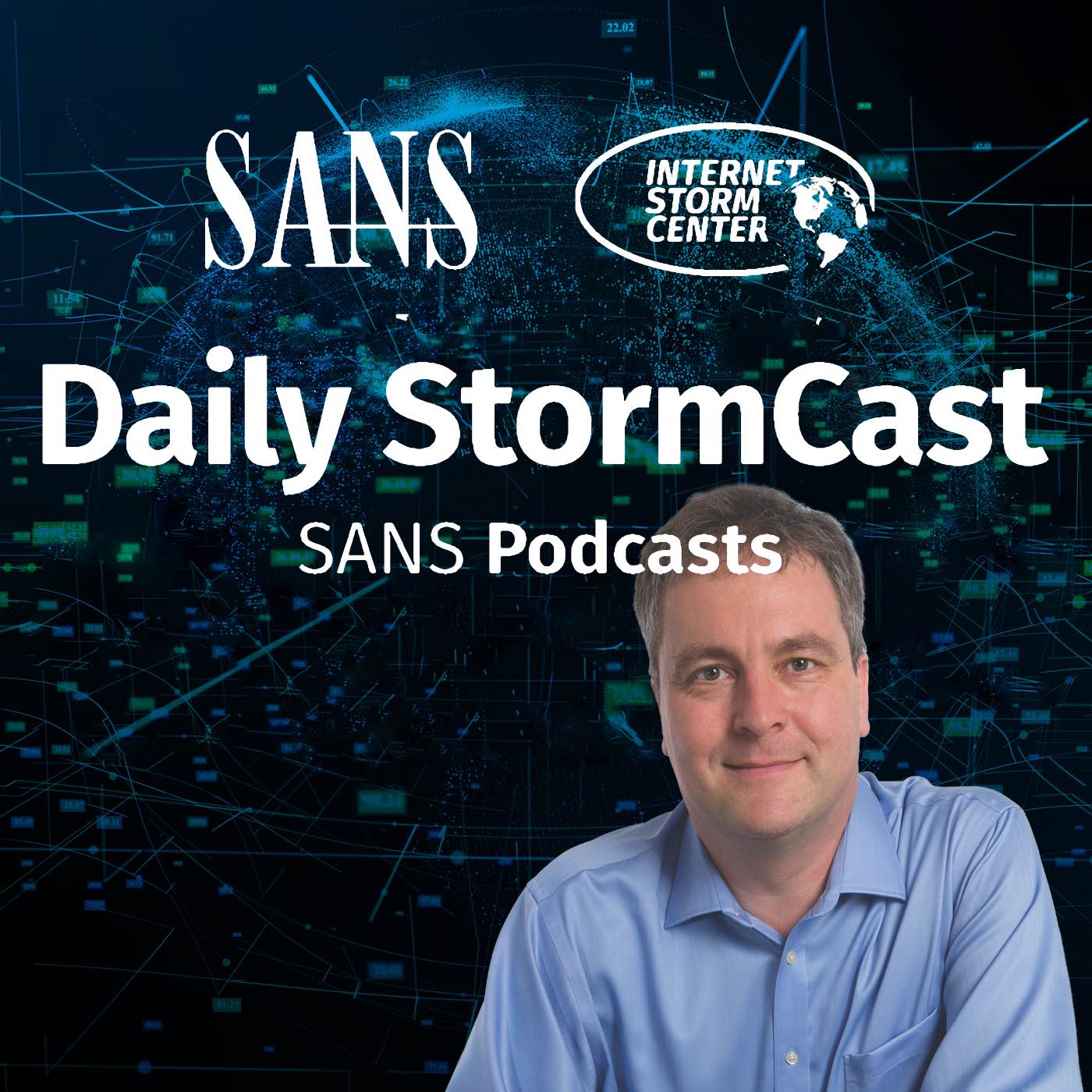Handler on Duty: Xavier Mertens
Threat Level: green
Podcast Detail
SANS Stormcast Monday, September 22nd, 2025: Odd HTTP Reuqest; GoAnywhere MFT Bug; EDR Freeze
If you are not able to play the podcast using the player below: Use this direct link to the audio file: https://traffic.libsyn.com/securitypodcast/9622.mp3
My Next Class
| Application Security: Securing Web Apps, APIs, and Microservices | Orlando | Mar 29th - Apr 3rd 2026 |
| Network Monitoring and Threat Detection In-Depth | Amsterdam | Apr 20th - Apr 25th 2026 |
Help Wanted: What are these odd requests about?
An odd request is hitting a number of our honeypots with a somewhat unusual HTTP request
header. Please let me know if you no what the request is about.
https://isc.sans.edu/forums/diary/Help+Wanted+What+are+these+odd+reuqests+about/32302/
Forta GoAnywhere MFT Vulnerability
Forta’s GoAnywhere MFT product suffers from a critical deserialization vulnerability. Forta released
an advisory disclosing the vulnerability on Thursday.
https://www.fortra.com/security/advisories/product-security/fi-2025-012
EDR Freeze
A new tool, EDR Freeze, allows regular users to suspend EDR processes.
https://www.zerosalarium.com/2025/09/EDR-Freeze-Puts-EDRs-Antivirus-Into-Coma.html
Discussion
New Discussions closed for all Podcasts older than two(2) weeks
Please send your comments to our Contact Form
| Application Security: Securing Web Apps, APIs, and Microservices | Orlando | Mar 29th - Apr 3rd 2026 |
| Network Monitoring and Threat Detection In-Depth | Amsterdam | Apr 20th - Apr 25th 2026 |
| Application Security: Securing Web Apps, APIs, and Microservices | San Diego | May 11th - May 16th 2026 |
| Network Monitoring and Threat Detection In-Depth | Online | Arabian Standard Time | Jun 20th - Jun 25th 2026 |
| Network Monitoring and Threat Detection In-Depth | Riyadh | Jun 20th - Jun 25th 2026 |
| Application Security: Securing Web Apps, APIs, and Microservices | Washington | Jul 13th - Jul 18th 2026 |
| Application Security: Securing Web Apps, APIs, and Microservices | Las Vegas | Sep 21st - Sep 26th 2026 |
Podcast Transcript
Hello and welcome to the Monday, September 22, 2025 edition of the SANS Internet Storm Center's Stormcast. My name is Johannes Ullrich, recording today from Las Vegas, Nevada. And this episode is brought to you by the SANS.edu Bachelor's Degree Program in Applied Cybersecurity. This weekend I tried a little bit something different with my diary, something that we have done in the past and I think haven't really done as much recently as we should. And that's, well, really just post an observation where I have no idea what it's about. And hopefully someone here in the audience or someone who read it on the SANS will be able to fill in some of the gaps here. The problem is an sort of interesting request that our honeypots have been seen lately. And of course, honeypots typically are being hit by sort of malicious requests. And that's why I suspect that this is some kind of maybe recon scan or whatever. The HTTP header that sort of made this request stick out is the X-Forwarded-App header. When you're dealing with proxies, they're usually like the X-Forwarded-Host, X-Forwarded-IP address, and headers like that being used to indicate if a request went through a proxy and, well, what the original client IP address was. This looks like something similar. And quite often, headers like this with proxies are being used to potentially bypass authentication, bypass access control, because, well, then the recipient believes that this is actually an already authenticated request that was authenticated by some proxy. That's my guess at this point. Now, the string, the value being provided with this app header is somewhat random. It's always app dot and then a couple of random characters. There are a couple additional headers like a license ID and such. All of it looks very much like a mobile device. So that may be another hint here what's going on. And the URL appears to be pointing to something like a QR code. So there are a few possibilities here. What could potentially be happening with these requests? If anybody has any insight into what's going on there, well, let me know. And it would be interesting to really sort of narrow this down what's happening here. It's just a little bit of hunch here, maybe nothing. But yeah, I have no idea what it is. Well, and then let's talk about vulnerabilities. On Thursday, Forta released an advisory disclosing just patched vulnerability in its Go Anywhere MFT product. That product is susceptible to a desolization vulnerability, or actually it's the license servlet in Go Anywhere MFT that is vulnerable here. An attacker does not need to be authenticated in order to actually exploit this vulnerability. And what they have to do is send a forged license response signature. That's sort of how they would trigger that desolization vulnerability. Of course, desolization vulnerabilities do allow for arbitrary code execution. And that turns this into an unauthenticated remote code execution vulnerability with a CVSS score of 10.0. In addition to patching, Forta advices that you should never ever expose the admin interface of this product to the public internet. That just expands your attack surface. And well, I guess there may be other vulnerabilities. Now, talking about other vulnerabilities in that product, a couple of years ago, this product had some similar vulnerabilities. And they were heavily used for ransomware. So definitely apply the update as quickly as possible. And also make sure that you reduce your attack surface and don't expose this admin interface. Well, and something for the offensive listeners here to the podcast, the Zero Salarium blog this weekend introduced a new anti -EDR tool that they are calling EDR Freeze. Well, other tools around that will block and kill some endpoint detection and response products or EDR products. But unlike some of these other tools, this tool actually doesn't attempt to terminate the EDR solution on the target. Instead, well, as the name implies, it just freezes it. It renders it unresponsive. The other interesting part about this technique is that it can be performed in user space only. And that's a very important distinction. A lot of the other techniques that counter EDR, they usually require something like a vulnerable driver that is then being used for privilege escalation. And then that access can be used in order to mess with the EDR solution. This is not necessary for this particular technique. Instead, well, Windows error reporting is used to interact with the target process. In this case, the EDR process. The tool takes advantage of the mini dump write dump function, which is really intended to sort of take a quick memory snapshot of a process. And that's useful for debugging. And in order to create that memory dump, well, the process has to be halted briefly. Now, this is usually not a problem because that's very short and the process will immediately resume after that memory dump has been collected. But Sir Solarium in their blog post also looked at how to overcome some of these limitations. There's also another issue they have to overcome, and that's the protected process light, which is essentially a flag that's set for anti -malware processes and such to provide some additional protection there. And well, in their blog post, they outline some tricks that they're using there. First of all, they're using a tool called WerFaultSecure that essentially is used to create these debug dumps and introduce faults. Basically, that's sort of what it does. So that overcomes the restrictions on these processes and allows normal user to interact with these processes. And then after they sort of attach this tool and create their memory dump, then they immediately start pulling that and that will then more or less indefinitely freeze the process. So that's basically put it in a suspend state. There's more detail in the blog post, how it all works and how to use it. The tool itself is made public on GitHub, so you can just download it and experiment with it. I haven't had a chance to do that yet. So as always, be careful. May do something completely different that tool, but that sounds like a reasonable approach to do this. Now, from a defensive point of view, and I'm always on the defensive side here, what you could do is you could basically monitor this WerFaultSecure tool. That's nothing that a user typically would be running. And then you can also monitor what arguments are being passed to it and check if any of the arguments, which is essentially the PID of the process you're interacting with, is the PID of one of these protected processes. Well, and this is it for today. So thanks again for listening and thanks for liking and subscribing to this podcast. As always, I'm in Vegas here at our network security conference this week. If you want to say hi, I'm teaching 522 here, SEC 522. So just look it up. I haven't seen what room I'll be exactly in yet, but it shouldn't be too hard to figure out. I usually carry some stickers and such around with me. I think I'll also do a presentation later this week and I'll announce that later. Well, that's it. Thanks and talk to you again tomorrow. Bye.











